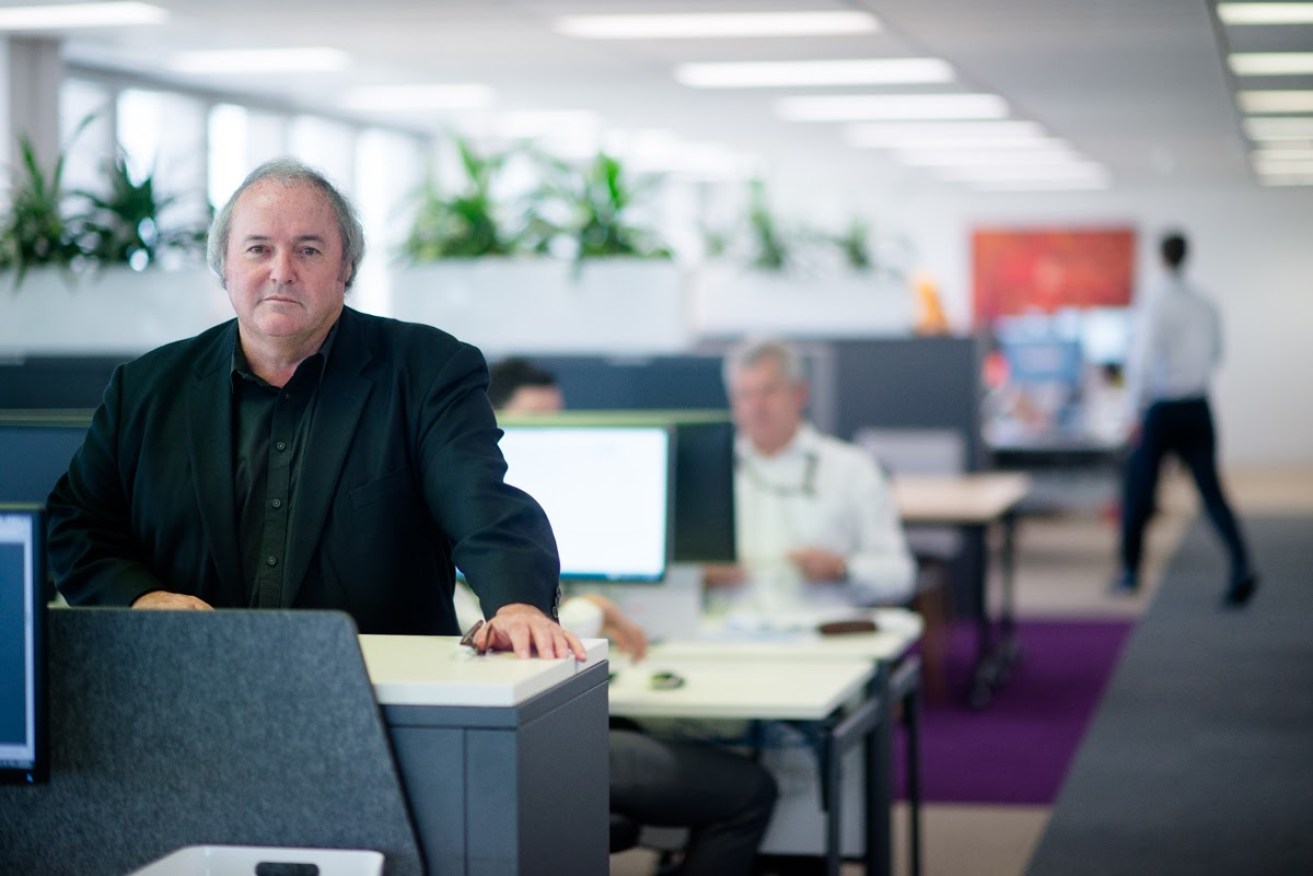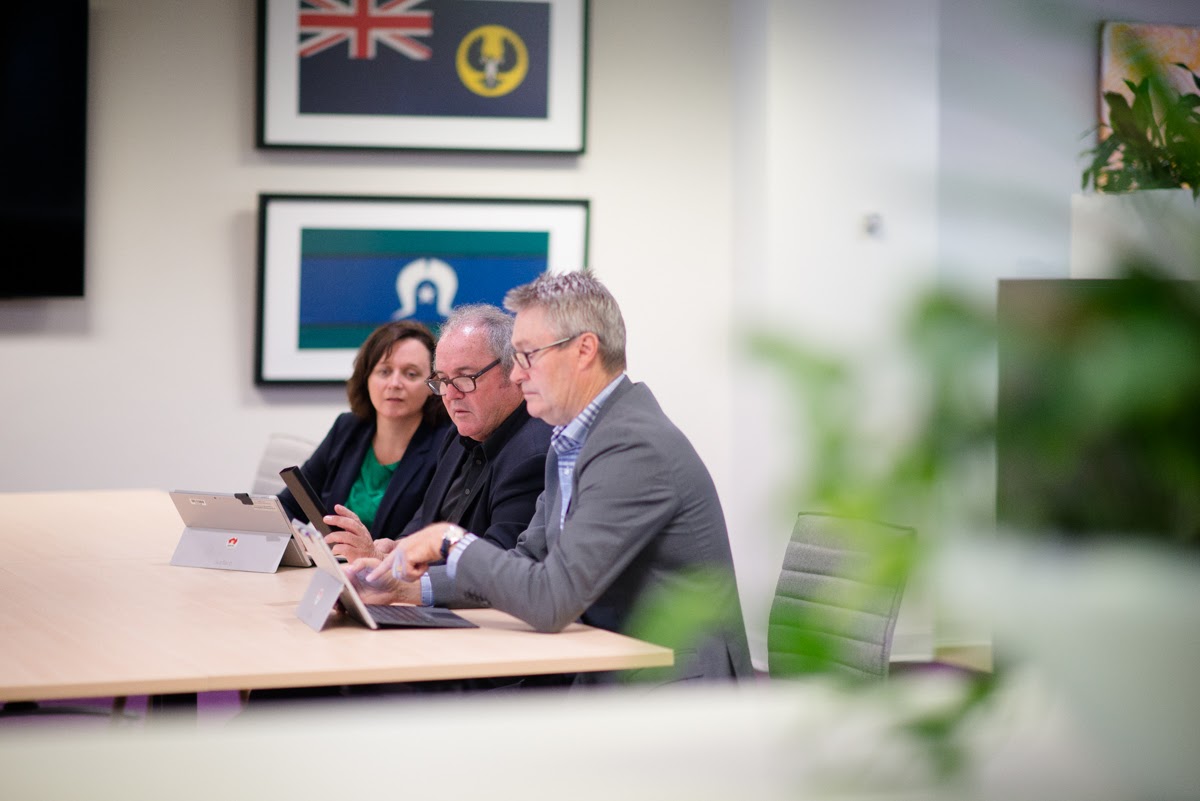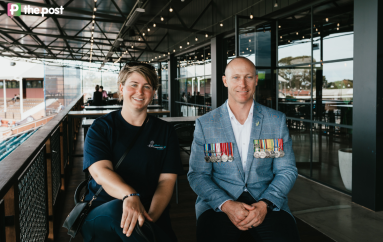Kym Winter-Dewhirst: The man with the plan, but no office
Jay Weatherill’s controversial departmental boss – Kym Winter-Dewhirst – isn’t taking a backward step. In a rare interview, he told InDaily why the public service needs to change and how his $500,000 office refit is not an indulgence, but a template for public sector reform.


Kim Winter-Dewhirst in the open-plan 16th-floor offices of Premier and Cabinet. Photo: Nat Rogers/InDaily
Kym Winter-Dewhirst made an immediate impact when he stepped into the Department of Premier and Cabinet almost exactly a year ago.
First, he unceremoniously offloaded 11 high-ranking executives – a decision he says he made before he even stepped in the door.
Then, he set about tearing up the carpet and pulling down office cubicles on Level 16 of the State Administration Centre to make way for an open-plan, ultra-modern fit-out of the kind more commonly seen in high-end consultancy firms than in Adelaide’s public sector offices.
He copped plenty of flak, particularly given that previous CEOs had also made their own mark on the Victoria Square building’s physical layout.
Shadow Treasurer Rob Lucas described the project as a “massive waste of taxpayers’ money”.
But Winter-Dewhirst is unfazed.
In fact, he’s planning more office fit-outs of a similar ilk, and is encouraging the entire public service to follow his lead.
The new office was officially opened in early February. It’s been designed in honour of local Aboriginal people and dubbed the “respect and reconciliation” floor. The opening even included an Aboriginal “smoking” ceremony.
Far from being sheepish about the expensive exercise, Winter-Dewhirst presents Level 16 as an emblem for public sector transformation. He met this reporter on the ground floor and took me immediately to Level 14 to demonstrate what the old lay-out looked like: it’s a bog-standard public service set-up with “workstations” – little cubicles – lined up for each worker.
There’s no doubting it’s drab: 50 shades of beige.
“I looked at it and thought, ‘I can’t work like this’,” Winter-Dewhirst says.
He was accustomed to something very different. Winter-Dewhirst joined Weatherill’s department in January last year, straight from global resources giant BHP Billiton, where open plan was de rigueur.
He wasn’t entirely unfamiliar with the public service, having spent several years as minister John Hill’s chief of staff during the Rann years and, previously, as a consultant to the Public Service Association in Adelaide. He also spent countless hours with State Government ministers and bureaucrats in his role overseeing large chunks of the proposed Olympic Dam expansion – a project that had almost mythical status under the Rann Government.
This experience left him with an overarching impression of that public sector – that it was “fertile ground for modernisation”.
We catch the lift to the 16th floor, and the doors open onto a very different world. The open-plan office feels spacious and slightly opulent, with one end of the floor dominated by a spacious kitchen area and a huge boardroom. Across the rest of the floor are banks of desks, both for seated and standing operation, plus meeting areas. “Quiet” areas are separated from “collaborative” areas with colour-coded carpet.
No-one has a personal desk or office – not even Winter-Dewhirst himself: a rarity for a public service boss on a substantial salary.
Every desk is “hot”, with personal belongings stored in lockers. It is very similar to the new KPMG offices on Hindmarsh Square, which are touted as a cutting-edge set-up.
Despite the feeling of space, Winter-Dewhirst points out that many more staff can work on Level 16 now compared to the previous set-up – in fact, triple the number. He says the floor now accommodates 80 staff, compared to the previous capacity of 40, and there’s room for even more.
He says the open-plan office is saving money in paper use (down nearly 60 per cent already) and printer toner cartridges, and will eventually save millions of dollars through the consolidation of tenancies.
In fact, he thinks open plan is so efficient that he’s going to replicate it on other floors of State Admin – and encourages other departments to follow his lead.
“Every dollar I spend on this program results in the return of $6,” he says.
“We want to run this program through the building, which will save $5 million to $6 million over the forward estimates.”
So he doesn’t feeling any discouragement at the flood of negative media coverage of his office fit-out?
“None whatsoever.”
And there’s plenty of work to do to bring together DPC’s staff, who are scattered over 12-13 floors in seven separate buildings across the CBD.
The Level 16 lay-out is just the start. The private-sector-inspired physical environment is complemented by new technology which Winter-Dewhirst says is designed to encourage collaboration. Staff now use Microsoft Surface Pro tablets, and use the boardroom facilities to work on shared documents in real-time, a process department bosses say has compressed some tasks – such as multi-agency cabinet submissions – from days of paper shuffling into just hours of face-to-face work.
By tearing down the physical walls, Winter-Dewhirst argues he’s also tearing down the “silos” which isolate public servants from each other and lead to inefficient, time-consuming decision-making.
All of this has happened, he contends, without having to go cap in hand to Treasury for more money.
Winter-Dewhirst says the office fit-out came from a re-allocation of existing resources – a process he insists on from his executives when they have grand plans.
One of his deputy directors, Tahnya Donaghy, who is in charge of policy and strategy, says the department hasn’t made any budget “bids” – submissions to Treasury for extra funding – for two years.
“In the first month I was here I set some basic rules,” Winter-Dewhirst says.
“Rule number one – and I’ve said it again and again – you cannot spend what you do not have. That challenged everyone, who were not quite used to doing that in many ways…
“People are now starting to think much more strategically about their part of the business… We don’t need to go to the budget process.”
“And we used to do that all the time,” Donaghy adds. “We’re really focusing on doing things in a mobile, agile way. When we deal with problems we’re really looking at doing it within existing resources, and that’s a big call to change.”
Another deputy director, chief operating officer Phil McMahon, told InDaily the office fit-out was paid for by making “efficiencies” in some areas, utilising capital previously earmarked for infrastructure replacement.
“We’re going to do a similar fit-out on Level 14 shortly in the same way – in this likeness,” McMahon says.
Winter-Dewhirst says he is also challenging traditional budget control measures.
His executive group’s Monday meeting tracks the departmental budget in real-time.
So far this year, the DPC executives say they are within budget.
“We will exceed our budget savings targets this year,” says McMahon.
Traditionally in the public service, departments who are on track to under-spend will lift their expenditure to make sure the budget is fully spent by the end of the financial year (the theory being that under-spending leaves an agency vulnerable to Treasury cuts for the next financial year).
Winter-Dewhirst is having none of that.
“I don’t hold any truck with that at all,” he says. “My view is give it back”.
He’s clearly not a fan of traditional modes of public service, which partly stems from his decade as a BHP executive negotiating with governments in Australia – including the South Australian Government – and overseas.
“I have to say from a company point of view, at times it was a very frustrating experience, and I’m sure they were frustrated by the company as well.”
So has his view of the public sector changed after a year on the inside?
“I think the place continues to be fertile ground for modernisation, and I think there’s considerable opportunity in various parts of the broader public sector to really make some 21st-century changes.”
The key weakness in the SA public sector, he says, is on the “delivery and implementation” end, “and that’s where we are trying to focus”.

Tahnya Donaghy, Kym Winter-Dewhirst and Phil McMahon in one of the collaborative working areas on Level 16. Photo: Nat Rogers/InDaily
DPC is a curious beast among South Australia’s public sector agencies. While a large part of its job is policy generation and coordination to service the Premier’s agenda, it also has a relatively large program function, delivering million of transactions to the public via Service SA, and overseeing shared services and procurement within the public sector.
However, its unique nature doesn’t stop Winter-Dewhirst from offering advice to other public sector chiefs, some of whom repeatedly struggle to hit their budgets.
“It’s a mistake to suggest one size fits all – whether it’s inside a large business or inside large government departments – but you can apply a set of principles that everybody aims to operate under.”
These include accurate forecasting of demand, for example, based on historical data (“that’s a pretty useful place to start”), a tightly controlled budget analysed weekly, clear accountabilities for leaders, and a scheduled list of “deliverables”.
Winter-Dewhirst has a reputation as a tough operator, which was only enhanced when his first move as DPC chief was to sack staff, including some long-standing managers, and restructure.
He says his speed – seen as unseemly in some quarters – was part of his “impatience” to get things done.
As with his office fit-out, he is unapologetic about “flattening out” what he describes as a “very steep pyramid of command”.
“There was nothing personal about it,” he says.
“I always felt that in this job time is my enemy… And so I decided I would make some significant changes and I would start at the top, and I would create opportunities for others to step up and seize a new agenda.”
It was a change he pondered while on “gardening leave” between the BHP and DPC jobs. The department had prepared 1400 pages of briefings for him – org charts, issues papers and much more (“the equivalent of Tolstoy”, he says drily).
“From a purely organisational point of view, I looked at it and thought, ‘boy – this is a complicated system’. It looked overly complex. It did appear to me at first blush that the place had been used as a somewhere where you put things in government where you hadn’t quite worked out where you put those other things.”
For those executives who survived his purge, you sense that the past year hasn’t been easy. And Winter-Dewhirst says he’s been putting a lot of pressure on them to perform.
Unusually for a contemporary public sector manager in an age where “work-life balance” is esteemed, he praises his management team’s culture of working very long hours.
And it seems that, at least among the two executives that spoke to InDaily, he has achieved some buy-in.
The Budget papers will tell the story about whether Winter-Dewhirst’s management clean-out and office rejuvenations have saved or cost money.
But one thing does seem certain – he won’t procrastinate about continuing to make changes to a department he says he views as a “business”.
“As these guys know, I can get a bit impatient about things,” he says.
“It’s a cultural change. Some things I’ve changed; some things I live with.
“These places (the public sector)… are one of the few places around where you get a pretty high level of well-educated people who understand policy, process. They do that very well. Perhaps delivery and implementation is always the weak element, and that’s where we are trying to focus.”




